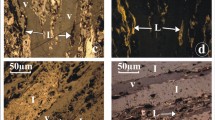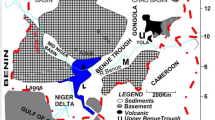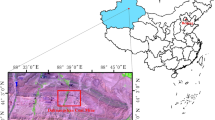Abstract
The Rock-Eval technique has been conventionally used for source-rock analysis. In this work we document the importance of Rock-Eval S4 oxidation graphics and S4-Tpeak as indicators for coal reactivity and thermal maturity. Two non-coking coals (lower maturity), one coking coal (higher maturity), and one jhama (intrusion-induced metamorphosed coal), were collected and studied in terms of their reactivity and combustion properties. Our results indicate that Rock-Eval S4-Tpeak can be convincingly used to decipher the thermal maturity level of a coal sample. The two non-coking coals owing to their higher reactivity and corresponding lower activation energies, combusted at lower temperatures, almost entirely below 650 °C, and showed lower Rock-Eval S4-Tpeak. The coking coal sample on the other hand due to its higher thermal maturity level and lower reactivity, combusted at higher temperature, showing higher S4-Tpeak. While the S2 Tmax showed higher maturity for the coking coal than the jhama, the S4 oxidation graphics and S4-Tpeak clearly revealed higher thermal maturity of the jhama relative to the other samples. With increasing sample weights, the S4CO2 curves were observed to be broader, and consequently the S4-Tpeak was observed to be higher and erroneous, the errors being more for the more-mature coking coal and jhama. With lowering sample weights, the curves became tighter and the S4-Tpeak became lower and more precise. Parameters calculated using TG-DTG-DSC were observed to complement the data from Rock-Eval oxidation-stage, and revealed higher maturity, less reactivity, higher temperatures of ignition and burn out for the jhama, followed by the coking coal. Our results also indicate the suitability of applying Rock-Eval for combustion-profiling of coals, beyond source-rock characterization and CBM reservoir analysis.





Similar content being viewed by others
References
Behar F, Beaumont V, De B, Penteado HL (2001) Rock-Eval 6 technology: performances and developments. Oil Gas Sci Technol Rev Inst Fr Pet Energ Nouv 56:111–134
Carrie J, Sanei H, Stern G (2012) Standardisation of Rock–Eval pyrolysis for the analysis of recent sediments and soils. Org Geochem 46:38–53
Carvajal-Ortiz H, Gentzis T (2015) Critical considerations when assessing hydrocarbon plays using Rock-Eval pyrolysis and organic petrology data: Data quality revisited. Int. J. Coal Geol 152:113–122
CMPDIL Coal Atlas of India 1st edition (1993) Central Mine Planning and Design Institute Ltd
Dahl B, Bojesen-Koefoed J, Holm A, Justwan H, Rasmussen E, Thomsen E (2004) A new approach to interpreting Rock-Eval S2 and TOC data for kerogen quality assessment. Org Geochem 35:1461–1477
Disnar JR, Guillet B, Keravis D, Di-Giovanni C, Sebag D (2003) Soil organic matter (SOM) characterization by Rock-Eval pyrolysis: scope and limitations. Org Geochem 34:327–343
Espitalié J, Laporte JL, Madec M, Marquis F, Leplat P, Pauletand J, Boutefeu A (1977) Methoderapide de caracterisation des roches meres, de leur potential petrolier et de leu degred’evolution. Inst Fr Pét 32:23–42
Espitalié J, Deroo G, Marquis F (1985) La pyrolyse Rock-Eval et ses applications. Première partie Revue de Inst Fr Pét 40:73–89
Hare AA, Kuzyk ZZA, Macdonald RW, Sanei H, Barber D, Stern GA, Wang F (2014) Characterization of sedimentary organic matter in recent marine sediments from Hudson Bay, Canada, by Rock-Eval pyrolysis. Org Geochem 68:52–60
Hazra B, Varma AK, Bandopadhyay AK, Mendhe VA, Singh BD, Saxena VK, Samad SK, Mishra D (2015) Petrographic insights of organic matter conversion of Raniganj basin shales, India. Int J Coal Geol 150-151:193–209
Hazra B, Dutta S, Kumar S (2017) TOC calculation of organic matter rich sediments using Rock-Eval pyrolysis: critical consideration and insights. Int J Coal Geol 169:106–115
Hazra B, Wood DA, Mani D, Singh PK, Singh AK (2019a) Evaluation of shale source rocks and reservoirs. Springer, Springer Nature
Hazra B, Karacan CÖ, Mani D, Singh PK, Singh AK (2019b) Insights from Rock-Eval analysis on the influence of sample weight on Hydrocarbon-generation from Lower Permian organic matter rich rocks, West Bokaro basin, India. Mar Petrol Geol 106:160–170
Hunt JM (1996) Petroleum geochemistry and geology, 2nd edn. WH Freeman and Company, New York, p 743
İnan S, Henderson S, Qathami S (2017) Oxidation Tmax: a new thermal maturity indicator for hydrocarbon source rocks. Org Geochem 113:254–261
Jarvie DM (2012) Shale resource systems for oil and gas: part 1—shale–gas resource systems. In: Breyer JA (ed) Shale Reservoirs—Giant Resources for the 21st Century, vol 97. AAPG Mem, pp 69–87
Jiang C, Chen Z, Lavoie D, Percival JB, Kabanov P (2017) Mineral carbon MinC(%) from Rock-Eval analysis as a reliable and cost-effective measurement of carbonate contents in shale source and reservoir rocks. Mar Petrol Geol 83:184–194
Katz BJ (1983) Limitations of “Rock-Eval” pyrolysis for typing organic matter. Org Geochem 4:195–199
Lafargue E, Espitalié J, Marquis F, Pillot D (1998) Rock–Eval 6 applications in hydrocarbon exploration, production, and soil contamination studies. Inst Fr Pét 53:421–437
Lu L, Sahajwalla V, Kong C, Harris D (2001) Quantitative X-ray diffraction analysis and its application to various coals. Carbon 39:1821–1833
Marchand C, Disnar JR, Lallier-Vergès E, Lottier N (2005) Early diagenesis of carbohydrates and lignin in mangrove sediments subject to variable redox conditions (French Guiana). Geochim Cosmochim Acta 69:131–142
Marchand C, Lallier-Vergès E, Disnar J-R, Kéravis D (2008) Organic carbon sources and transformations in mangrove sediments: a Rock-Eval pyrolysis approach. Org Geochem 39(4):408–421
Meyers PA, Lallier-Vergès E (1999) Lacustrine sedimentary organic matter records of late quaternary paleoclimates. J Paleolimnol 21(3):345–372
Mishra HK, Cook AC (1992) Petrology and thermal maturity of coals in the Jharia Basin. Implications for Oil and Gas Origins. Int J Coal Geol 20:277–313
Mishra HK, Chandra TK, Verma RP (1990) Petrology of some Permian coals of India. Int J Coal Geol 16:47–71
Peters KE (1986) Guidelines for evaluating petroleum source rock using programmed pyrolysis. AAPG Bull 70:318–386
Peters KE, Cassa MR (1994) Applied source rock geochemistry. In: Magoon LB, Dow WG (eds) The Petroleum System d from Source to Trap. AAPG Memoir, pp 93–120
Pillot D, Deville E, Prinzhofer A (2014) Identification and quantification of carbonate species using Rock-Eval pyrolysis. Oil Gas Sci Technol- Rev IFP 69(2):341–349
Poot A, Quik TKJ, Veld H, Koelmans AA (2009) Quantification methods of Black Carbon: comparison of Rock-Eval analysis with traditional methods. J Chromatogr A 1216:613–622
Poot A, Jonker MTO, Gillissen F, Koelmans AA (2014) Explaining PAH desorption from sediments using Rock Eval analysis. Environ Pollut 193:247–253
Romero-Sarmiento M-F, Pillot D, Letort G, Lamoureux-Var V, Beaumont V, Huc A-Y, Garcia B (2016) New Rock-Eval method for characterization of unconventional shale resource systems. Oil Gas Sci Technol 71:37
Sahu SG, Sarkar P, Chakraborty N, Adak AK (2010) Thermogravimetric assessment of combustion characteristics of blends of a coal with different biomass chars. Fuel Process Technol 91:369–378
Sarkar NB, Sarkar P, Choudhury A (2005) Effect of hydrothermal treatment of coal on oxidation susceptibility and electrical resistivity of HTT coke. Fuel Process Technol 86:487–497
Sebag D, Disnar JR, Guillet B, Di Giovanni C, Verrecchia EP, Durand A (2006) Monitoring organic matter dynamics in soil profiles by ‘Rock–Eval pyrolysis’: bulk characterization and quantification of degradation. Eur J Soil Sci 57:344–355
Sebag D, Debret M, Makaya M, Mabicka R, Ngomanda A, Oslisly R, Bentaleb I, Disnar J-R, Giresse P (2013) Coupled Rock-Eval pyrolysis and spectrophotometry for lacustrine sedimentary dynamics: application for west central African rainforests (Kamalété and Nguène, Gabon). The Holocene 23:1173–1183
Shi Q, Qin B, Bi Q, Qu B (2018) An experimental study on the effect of igneous intrusions on chemical structure and combustion characteristics of coal in Daxing Mine, China. Fuel 226:307–315
Singh AK, Singh MP, Sharma M, Srivastava SK (2007) Microstructures and microtextures of natural cokes: a case study of heat-altered coking coals from the Jharia Coalfield, India. Int J Coal Geol 71:153–175
Singh AK, Singh MP, Sharma M (2008) Genesis of natural cokes: Some Indian examples. Int J Coal Geol 75:40–48
Ulloa C, Borrego AG, Helle S, Gordon AL, García X (2005) Char characterization and DTF assays as tools to predict burnout of coal blends in power plants. Fuel 84:247–257
Acknowledgments
The Director CSIR- Central Institute of Mining and Fuel Research is thankfully acknowledged for giving necessary infrastructure and permission to conduct the research work. The Director, CSIR-Central Institute of Mining and Fuel Research, is also acknowledged for giving B. Hazra CSIR-CIMFR in-house research grant (project no.: MLP-93/2019-20), the funds of which were utilized to conduct the experiments. Dr Devleena Mani is acknowledged for her help in conducting the Rock-Eval analysis.
Author information
Authors and Affiliations
Corresponding author
Additional information
Responsible Editor: Santanu Banerjee
Electronic supplementary material
ESM 1
(DOCX 2050 kb)
Rights and permissions
About this article
Cite this article
Hazra, B., Sarkar, P., Chakraborty, P. et al. Coal combustion analysis using Rock-Eval: importance of S4-Tpeak. Arab J Geosci 13, 475 (2020). https://doi.org/10.1007/s12517-020-05476-7
Received:
Accepted:
Published:
DOI: https://doi.org/10.1007/s12517-020-05476-7




